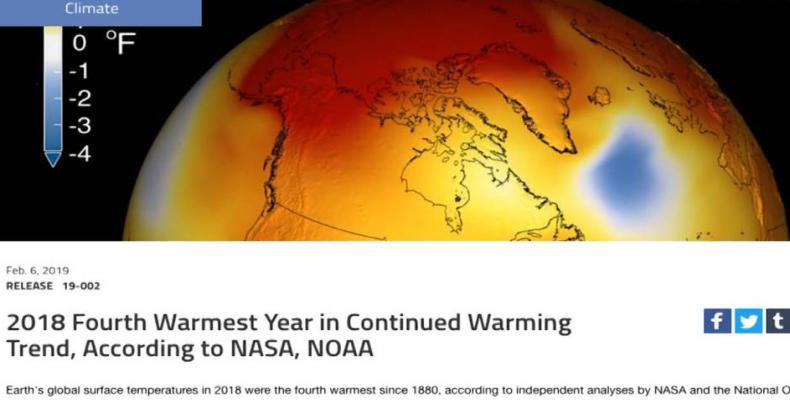The last four years have been the warmest since the pre- industrial era -- that is between 1850 and 1900 -- and United Nations experts say this dangerous anomaly is the result of the record accumulation of greenhouse gases in the Earth’s atmosphere.
The year 2016, a period marked by the influence of the El Niño current, was the hottest since records are kept, with an increase of 1.2 degrees centigrade over normal, according to a report presented this week.
Although from 2015 to 2018, the temperature rose one degree centigrade, global warming has been increasing over the past two decades, according to Petteri Taalas, General Secretary of the World Meteorological Organization.
This specialist warned that humankind must emphasize the struggle against the emission of contaminating gases and work for the adoption of measures to neutralize climate change, which is provoking extreme climatic disturbances affecting millions and millions of people around the world.
The current tendency will not be turned around this year, and an example of this is shown by the fact that Australia has just experienced the warmest January in its history. The extreme cold wave that recently affected extensive areas in the United States and Europe ls another example.
The reason seems to be that the Poles are warming up at a rate higher than the rest of our Planet, resulting in climatic disturbances which affect scores of millions of persons.
Recently, a study conducted by some 350 climatic researchers warned that if current conditions continue, two-thirds of the Himalayan glaciers will melt before the end of this century, a disaster that will gravely affect the lives and livelihoods of two billion persons on Earth.
Some thirty five thousand kilometers long, from Afghanistan to Burma, the Himalayas mountain chain is considered as to be the Earth’s third pole, because of the huge amount of ice it keeps.
However, even if the Paris Accords were fulfilled and global warming was kept under one and a half degrees centigrade below the pre-industrial era, the melting of two-thirds of the those glaziers seems inevitable.
This catastrophe will cause drastic changes in the flow of big rivers, such as the Ganges, the Mekong and the Yellow River, and will affect food production in densely populated areas.
The disturbances that this phenomenon will bring to a highly populated area will force changes in agricultural and industrial methods and will inevitably impact the lives of hundreds of millions of persons.
These victims of the greed of Western industrial powers must take appropriate measures to face the destruction that will be inflicted on them, the result of the insatiable appetite of Western powers and the governments that rule on their behalf.
Planet Earth continues to dangerously heat up

Matérias relacionadas
Comentários
Deixe um comentário
Todos os campos são requeridosMais vistas
- Cuba ajuda países a suprir a falta de recursos humanos na área de saúde
- Cuba Saúde 2025, um evento em Havana para o bem-estar universal
- Luto oficial em Cuba pelo falecimento de Francisco
- Feira Internacional de Saúde consolida o papel de Cuba na biotecnologia
- Católicos de Cuba expressam pesar pela morte de Francisco

